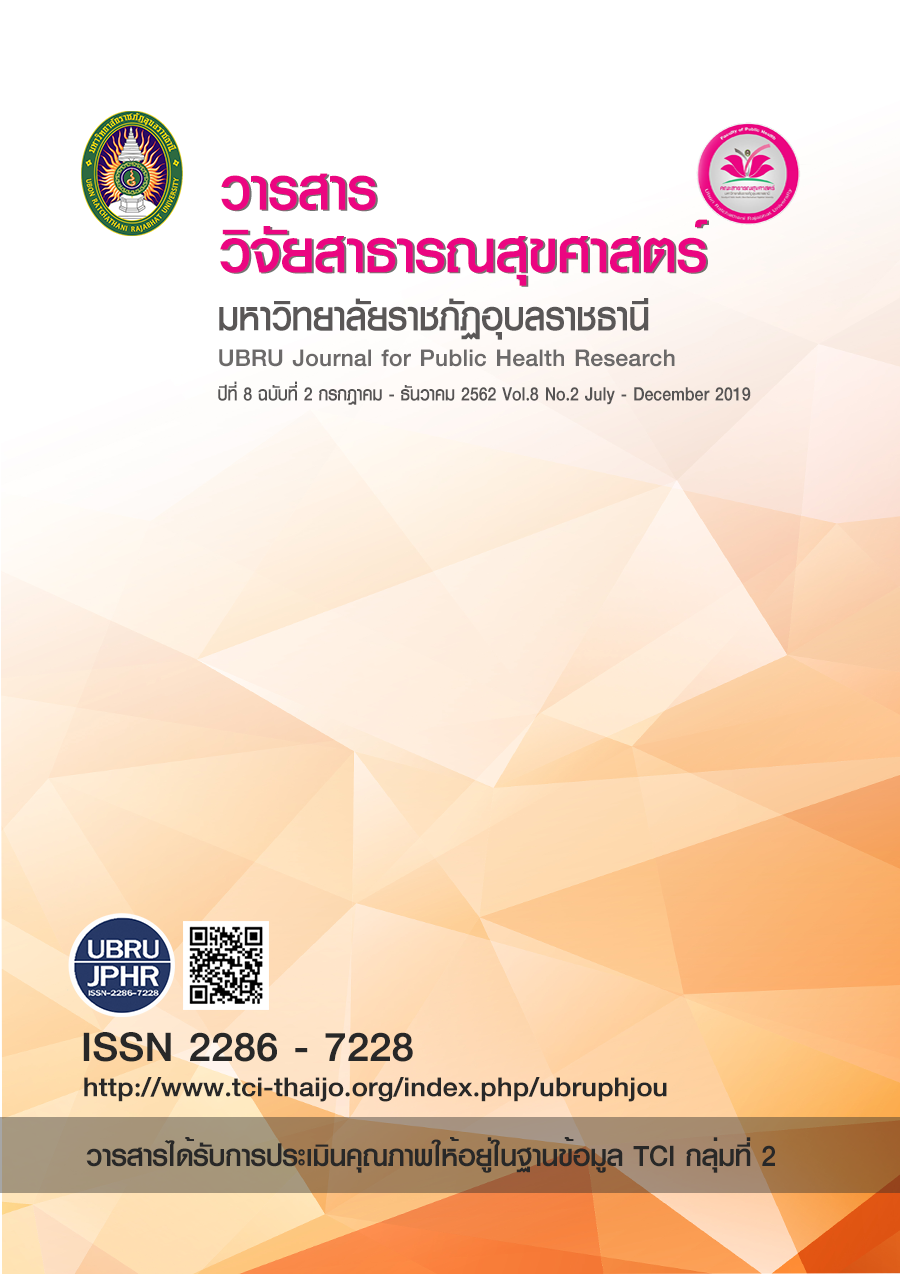พฤติกรรมการใช้ยาต้านจุลชีพ: กรณีศึกษาประชาชนบ้านก้างปลา ตำบลชัยพฤกษ์ อำเภอเมือง จังหวัดเลย
คำสำคัญ:
พฤติกรรมการใช้ยาต้านจุลชีพ, ยาต้านจุลชีพ, ประชาชนบทคัดย่อ
การวิจัยเรื่องนี้มีวัตถุประสงค์เพื่อ (1) ศึกษาพฤติกรรมการใช้ยาต้านจุลชีพ และ (2) วิเคราะห์ความสัมพันธ์ระหว่างปัจจัยส่วนบุคคลและความรู้กับพฤติกรรมการใช้ยาต้านจุลชีพ กลุ่มตัวอย่างคือประชาชนบ้านก้างปลา ตำบลชัยพฤกษ์ อำเภอเมือง จังหวัดเลย จำนวน 342 คน เครื่องมือที่ใช้ในการวิจัยเป็นแบบสอบถาม วิเคราะห์ข้อมูลส่วนบุคคล ความรู้ และพฤติกรรมการใช้ยาต้านจุลชีพ โดยใช้สถิติเชิงพรรณนา และวิเคราะห์ความสัมพันธ์ระหว่างอายุ เพศ อาชีพ ระดับการศึกษา สถานภาพสมรส รายได้ของครอบครัว (ต่อเดือน) และความรู้กับพฤติกรรมการใช้ยาต้านจุลชีพ โดยใช้สถิติ Chi-square (c2) และสถิติสัมประสิทธิ์สหสัมพันธ์เพียร์สัน
ผลการวิจัยพบว่ากลุ่มตัวอย่างส่วนใหญ่เคยใช้ยาต้านจุลชีพรักษา โรคคออักเสบ ทอนซิลอักเสบ คิดเป็นร้อยละ 36.0 มีความรู้เกี่ยวกับการใช้ยาต้านจุลชีพส่วนใหญ่อยู่ในระดับปานกลาง ร้อยละ 45.9 มีพฤติกรรมการใช้ยาต้านจุลชีพโดยรวมอยู่ในระดับที่ปลอดภัยปานกลาง ร้อยละ 57.3 ปัจจัยด้านอาชีพมีความสัมพันธ์กับพฤติกรรมการใช้ยาต้านจุลชีพ อย่างมีนัยสำคัญทางสถิติ (c2 = 33.865, p<0.05) ปัจจัยด้านอายุและรายได้ของครอบครัว (ต่อเดือน) มีความสัมพันธ์ทางลบกับพฤติกรรมการใช้ยาต้านจุลชีพ (r = -1.198, -1.229, p<0.05) ในขณะที่ปัจจัยด้านความรู้ พบว่า มีความสัมพันธ์ทางบวกกับพฤติกรรมการใช้ยาต้านจุลชีพ อย่างมีนัยสำคัญทางสถิติ (r = 0.246, p<0.05) ส่วนปัจจัยด้านเพศ ระดับการศึกษา และสถานภาพสมรส ไม่มีความสัมพันธ์กับพฤติกรรมการใช้ยาต้านจุลชีพ
ผลการศึกษานี้ชี้ให้เห็นว่าความรู้มีความสัมพันธ์ทางบวกกับพฤติกรรมการใช้ยาต้านจุลชีพ ดังนั้นควรมีการส่งเสริมความรู้เกี่ยวกับการใช้ยาต้านจุลชีพอย่างสมเหตุสมผลให้กับประชาชน เพื่อป้องกันปัญหาการใช้ยาต้านจุลชีพไม่เหมาะสม
เอกสารอ้างอิง
คุณากร ปาปะขา และ วงศา เล้าหศิริวงศ์. (2561). สถานการณ์ และปัจจัยที่มีความสัมพันธ์กับการใช้ยาปฏิชีวนะของกลุ่มวัยแรงงานในจังหวัดมหาสารคาม. วารสารวิทยาลัยพยาบาลบรมราชชนนี กรุงเทพ. 34(2), 13-22.
จิรชัย มงคลชัยภักดิ์, จิรวัฒน์ รวมสุข และเอมอร ชัยประทีป. (2555). การศึกษาความรู้และพฤติกรรมเกี่ยวกับการใช้ยาปฏิชีวนะของผู้รับบริการ ในร้านยาชุมชนจังหวัดปทุมธานี. วารสารวิชาการมหาวิทยาลัยอิสเทิร์นเอเชีย. 6(2), 91-100.
เจตนิพิฐ สมมาตย์ และพิมพ์ศิริ อุยวัฒนกุล. (2559). ปัจจัยที่มีผลต่อพฤติกรรมการใช้ยาปฏิชีวนะของนักเรียนชั้นมัธยมศึกษาตอนปลายจังหวัดขอนแก่น. วารสารเภสัชศาสตร์อีสาน. 12(1), 25-33.
ณัฐวรรณ สุวรรณ และอัจฉราพร ศรีภูษณาพรรณ. (2547). รายงานการวิจัย เรื่อง ความรู้และพฤติกรรมการใช้ยาต้านจุลชีพของนักเรียนมัธยมศึกษาตอนปลายในอำเภอเมือง จังหวัดเชียงใหม่. เชียงใหม่: คณะพยาบาลศาสตร์ มหาวิทยาลัยเชียงใหม่.
นัชชา ยันติ. (2560). ปัจจัยที่มีความสัมพันธ์ต่อพฤติกรรมการใช้ยาปฏิชีวนะของนักศึกษาหลักสูตรสาธารณสุขศาสตร์ มหาวิทยาลัยแห่งหนึ่ง จังหวัดปทุมธานี. วารสารวไลยอลงกรณ์ปริทัศน์ (มนุษยศาสตร์และสังคมศาสตร์). 7(2), 57-66.
บุญชม ศรีสะอาด. (2538). วิธีการทางสถิติสำหรับการวิจัย. พิมพ์ครั้งที่ 2. กรุงเทพฯ: สุวีริยาสาส์น.
พิสนธิ์ จงตระกูล. (2554). แนวทางการใช้ยาปฏิชีวนะอย่างสมเหตุผล. กรุงเทพฯ: สำนักพิมพ์อักษรกราฟฟิคแอนด์ดีไซน์.
พรรณรวี โพธิ์เทียนทอง. (2559). Antimicrobial resistance: a global concern. วารสารเพื่อการวิจัยและการพัฒนาองค์การเภสัชกรรม. 23(3), 9-12.
โรงพยาบาลส่งเสริมสุขภาพตำบลก้างปลา. (2560). สถิติการใช้ยาต้านจุลชีพของประชาชนหมู่บ้านก้างปลา ตำบลชัยพฤกษ์ อำเภอเมือง จังหวัดเลย ประจำปี 2560. เลย: โรงพยาบาลส่งเสริมสุขภาพตำบลบ้านก้างปลา.
วิลาวัณย์ อุ่นเรือน และ ดลวิวัฒน์ แสนโสม. (2558). พฤติกรรมการใช้ยาปฏิชีวนะของนักศึกษามหาวิทยาลัยขอนแก่นในอาการ เจ็บคอ บาดแผลสะอาด ท้องร่วง. วารสารวิจัยสถาบันมหาวิทยาลัยขอนแก่น. 3(3), 221-232.
ศุภลักษณ์ สุขไพบูลย์, ชุภาศิริ อภินันท์เดชา และกวี ไชยศิริ. (2559). พฤติกรรมการใช้ยาปฏิชีวนะของ ผู้รับบริการ โรงพยาบาลส่งเสริมสุขภาพตำบลสร่างโศก อำเภอบ้านหมอ จังหวัดสระบุรี. การประชุมวิชาการและเสนอผลงานวิจัยระดับชาติ ครั้งที่ 3 ก้าวสู่ทศวรรษที่ 2: บูรณาการงานวิจัย ใช้องค์ความรู้ สู่ความยั่งยืน”, หน้า 409 – 416. 17 มิถุนายน 2559. วิทยาลัยนครราชสีมา อำเภอเมือง จังหวัดนครราชสีมา.
สุณิชา ชานวาทิก, อังคณา เลขะกุล, วุฒิพันธุ์ วงษ์มงคล, วลัยพร พัชรนฤมล, อภิชาติ ธัญญาหาร และวิโรจน์ ตั้งเจริญเสถียร. (2561). สถานการณ์การใช้ยาต้านจุลชีพและความรู้เรื่องยาต้านจุลชีพ: ข้อมูลจากการสำรวจอนามัยและสวัสดิการ พ.ศ. 2560. วารสารวิจัยระบบสาธารณสุข. 12(3), 420-436.
สุวัฒน์ ปริสุทธิวุฒิพร และ มัณฑนา เหมชะญาติ. (2557). ปัจจัยที่มีผลต่อพฤติกรรมการใช้ยาปฏิชีวนะของผู้รับบริการในโรงพยาบาลขลุง จังหวัดจันทบุรี. วารสารศูนย์การศึกษาแพทย์คลินิกโรงพยาบาลพระปกเหล้า. 31(2), 114-127.
Bull World Health Organ. (2016). United Nations meeting on antimicrobial resistance. [online]. Available from:https://www.who.int/bulletin/volumes/94/9/16-020916.pdf/ doi: 10.2471/BLT.16.020916. [cited 10 November, 2017]
Health Systems Research Institute and Coordination and Integration Committee on Antimicrobial Resistance. (2017). Thailand national strategic plan on antimicrobial resistance 2017-2021. [online]. Available from: http://narst.dmsc.moph.go.th/documentation/AMR%20strategy%202560-2564.pdf. [cited 10 November, 2017]
Jonas, O.B., Irwin, A., Berthe, F. C. J., Le Gall, F. G., & Marquez, P.V. (2017). Drug-resistant infections: a threat to our economic future. Executive summary. Washington: International Bank for Reconstruction and Development/the World Bank; Report No.114679.
Review on antimicrobial resistance. (2014). Antimicrobial resistance: tackling a crisis for the health and wealth of nations. [online]. Available from: https://amrreview.org/sites/default/files/AMR%20Review%20Paper%20%20Tackling% 20a%20crisis%20for%20the%20health%20and%20wealth%20of%20nations_1.pdf. [cited 10 November, 2017]
ดาวน์โหลด
เผยแพร่แล้ว
รูปแบบการอ้างอิง
ฉบับ
ประเภทบทความ
สัญญาอนุญาต
เนื้อหาและข้อมูลในบทความที่ลงตีพิมพ์ในวารสารวารสารวิจัยสาธารณสุขศาสตร์ มหาวิทยาลัยราชภัฏอุบลราชธานี ถือเป็นข้อคิดเห็นและความรับผิดชอบของผู้เขียนบทความโดยตรงซึ่งกองบรรณาธิการวารสาร ไม่จำเป็นต้องเห็นด้วย หรือร่วมรับผิดชอบใดๆ
บทความ ข้อมูล เนื้อหา รูปภาพ ฯลฯ ที่ได้รับการตีพิมพ์ในวารสารนี้ ถือเป็นลิขสิทธิ์ของวารสารฯ หากบุคคลหรือหน่วยงานใดต้องการนำทั้งหมดหรือส่วนหนึ่งส่วนใดไปเผยแพร่ต่อหรือเพื่อกระทำการใดๆ จะต้องได้รับอนุญาตเป็นลายลักอักษรณ์จากบรรณาธิการวารสารนี้ก่อนเท่านั้น


